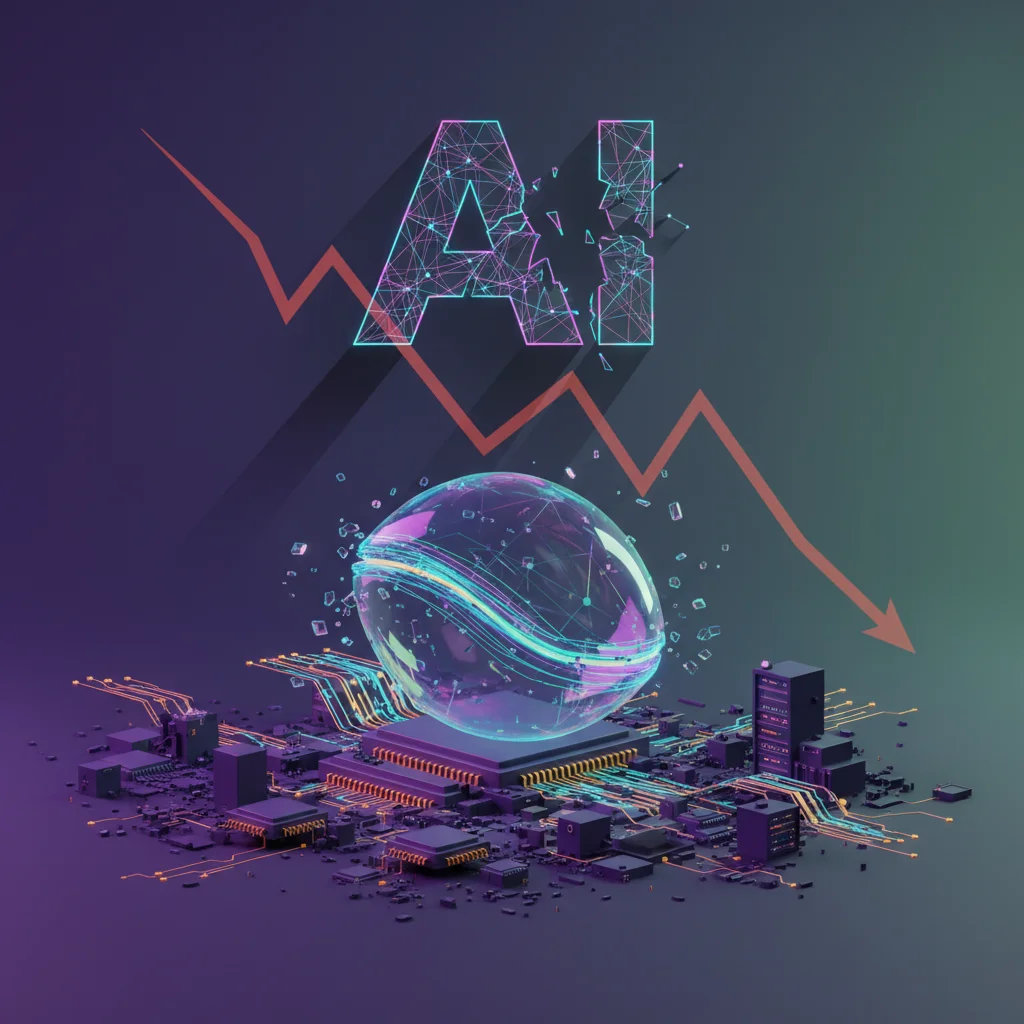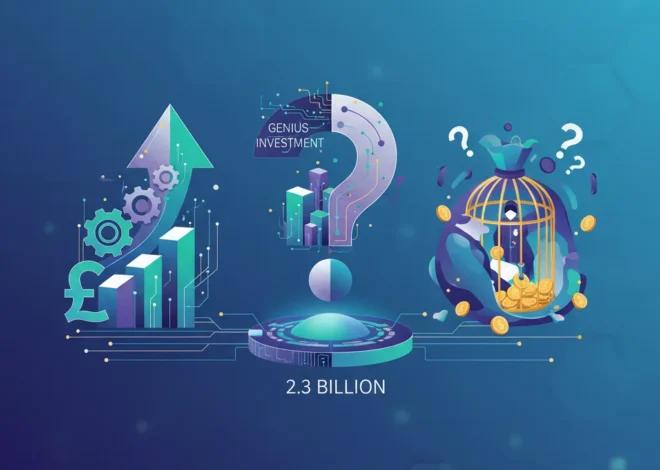
Silicon Valley’s AI Hangover: Is the Bubble About to Burst?
It’s impossible to ignore. From our social media feeds to our boardrooms, artificial intelligence has become the defining technology of our time. Generative AI tools are writing code, designing marketing campaigns, and even helping doctors diagnose illnesses. The excitement is palpable, and the investment dollars are flowing like a tidal wave. Venture capitalists are pouring billions into any startup with “.ai” in its name, and tech giants are reorienting their entire businesses around this new paradigm.
But beneath the shimmering surface of this AI gold rush, a sense of unease is beginning to creep in. In the hushed conversations of Silicon Valley cafes and the candid discussions in VC boardrooms, a single, nagging question is being asked with increasing frequency: Are we in an AI bubble? And if so, when does it pop?
The parallels to past tech manias are hard to miss. The unbridled optimism, the sky-high valuations for pre-revenue companies, and the pervasive feeling that “this time it’s different” all echo the dot-com boom of the late 90s and the more recent crypto frenzy. As the Financial Times recently highlighted, Silicon Valley is finally taking a moment to take stock, and the findings are sobering.
The “Picks and Shovels” Play: Who’s Really Winning the AI Gold Rush?
During the California Gold Rush, the most enduring fortunes weren’t made by the thousands of prospectors panning for gold, but by the merchants who sold them the picks, shovels, and blue jeans. The same dynamic is playing out today in the world of AI.
The undisputed early winners are the infrastructure providers. Companies like Nvidia, which designs the GPUs essential for training and running large language models (LLMs), have seen their valuations soar to astronomical heights. Similarly, the major cloud computing platforms—Amazon Web Services, Microsoft Azure, and Google Cloud—are reaping massive rewards by renting out the immense computational power required to fuel this revolution. They are the digital landlords, and the rent is high.
This has created a challenging environment for the thousands of startups trying to build applications on top of this infrastructure. While the barrier to entry for creating a simple AI-powered tool has never been lower (thanks to APIs from OpenAI, Anthropic, and others), the barrier to building a sustainable, profitable business has never been higher. Many of these companies are essentially “thin wrappers”—slick user interfaces built on top of someone else’s foundational model. Their primary value proposition is often convenience rather than deep, defensible innovation.
The problem is that this business model is incredibly fragile. What happens when the foundational model provider launches a similar feature? What happens when your competitor can build the same product in a weekend? And most critically, how do you maintain profitability when a significant portion of your revenue is immediately paid out to your cloud and API providers?
Verisure's IPO Boom: Why a Security Company's Success is a Game-Changer for AI and Cybersecurity
Echoes of the Past: Is History Repeating Itself?
For those who have been in the tech industry for a few decades, the current climate feels eerily familiar. The rush to build an “AI-native” SaaS product mirrors the rush to get a “.com” domain in 1999. To understand the potential risks, it’s helpful to compare the two eras.
Here’s a breakdown of the similarities and differences between the Dot-Com Bubble and the current AI Boom:
| Feature | The Dot-Com Bubble (~1999) | The AI Boom (~2024) |
|---|---|---|
| Core Infrastructure | The Internet, Web Browsers, ISPs | Cloud Computing, GPUs (Nvidia), Foundation Models (OpenAI) |
| Killer Application | E-commerce, Search Engines, Portals | Generative AI, Chatbots, Code Assistants, Image Generation |
| Primary Business Model | Advertising (“eyeballs”), E-commerce | SaaS, API-based services, Consumption-based pricing |
| Investor Mentality | “Get big fast,” growth over profit, fear of missing out (FOMO) | “AI-first,” massive funding rounds for pre-product teams, intense FOMO |
| Primary Risk | Unproven business models, low barriers to entry, high marketing spend | High compute costs, lack of defensibility (“moats”), dependency on platform providers |
The table highlights a crucial point: while the underlying technology is different, the human and market dynamics are strikingly similar. The current boom is fueled by a belief in a technological revolution, but as one venture capitalist noted in the FT, there’s a growing concern that many application-layer companies are “just features, not businesses.” (source) The fundamental challenge remains the same: how do you build a lasting competitive advantage?
Think about it: the dot-com crash wiped out countless companies like Pets.com and Webvan, but it also gave us Amazon and Google. The key takeaway is that the underlying technology—the internet—was real and transformative. The bubble was in the application layer, where hundreds of companies failed to find a sustainable business model.
We’re seeing the same pattern with artificial intelligence. The core innovation in machine learning and large-scale models is undeniably real. The “bubble” is forming around the thousands of startups building thin, undifferentiated applications on top of this new platform. Many of these will fail. But the companies that successfully integrate AI into complex workflows, leverage proprietary data, and solve high-value business problems will become the giants of the next generation. The question for entrepreneurs and investors isn’t “Is AI real?” but “Where can we build a durable business with AI that isn’t just a feature of a larger platform?”
Beyond the Code: What Tech Startups Can Learn from Indie Video Games
How to Survive the Shakeout: Building a Defensible AI Business
For entrepreneurs, developers, and tech professionals, navigating this hype cycle is the challenge of the decade. The allure of easy venture funding is strong, but building a company that can withstand the inevitable market correction requires discipline and strategic foresight. So, how can you build a moat in the age of AI?
1. Focus on Proprietary Data and Vertical Expertise
The most powerful defense is a unique dataset that foundational models haven’t been trained on. A general-purpose model like GPT-4 is a jack-of-all-trades, but a master of none. A startup that builds a model fine-tuned on decades of specific legal case law, financial data, or medical research will always outperform a generalist model in that niche. This is where true value and defensibility lie.
2. Integrate Deeply into Workflows
Instead of building a standalone gadget, build an indispensable tool that embeds AI deep within a customer’s existing business processes. Think about automation that connects to a company’s CRM, ERP, and internal databases. The stickier your product is and the more integrated it becomes, the harder it is to replace. This requires sophisticated software engineering and a deep understanding of the customer’s pain points.
3. Master the Economics of Compute
The dirty secret of the AI boom is the astronomical cost of compute. A recent report suggested that some AI startups are spending as much as 80 cents of every dollar of revenue on cloud infrastructure. This is simply not sustainable. Successful companies will be those that obsess over efficiency. This includes using smaller, more specialized models, optimizing programming for performance, and developing clever caching strategies. This isn’t just an engineering problem; it’s a core business strategy.
4. Solve a High-Stakes Problem
The most resilient AI companies will be those that solve mission-critical problems. A great example is cybersecurity. Using AI to detect network intrusions in real-time or identify sophisticated phishing attacks provides immediate, measurable value that companies are willing to pay a premium for. Compare that to an AI tool that generates slightly better marketing copy—one is a “must-have,” the other is a “nice-to-have.”
Cracking the Code: How India is Building an AI to Unite a Nation of 22 Languages
The Road Ahead: From Hype to Reality
The AI revolution is real, but the current market frenzy has all the hallmarks of a classic speculative bubble. A correction is not just possible; it’s likely. This shakeout will be painful for many, washing away the companies built on hype and weak foundations.
But it will also clear the path for a new generation of enduring, transformative companies. These will be the businesses that use artificial intelligence not as a gimmick, but as a powerful tool to solve fundamental problems. They will be built on proprietary data, deep workflow integration, and sound economic principles.
The gold rush phase is exciting, but it’s fleeting. The next phase—the one focused on building the sustainable railroads, cities, and economies of this new technological frontier—is where the real, lasting value will be created. The question for all of us in the tech world is: are we just panning for gold, or are we building the future?


